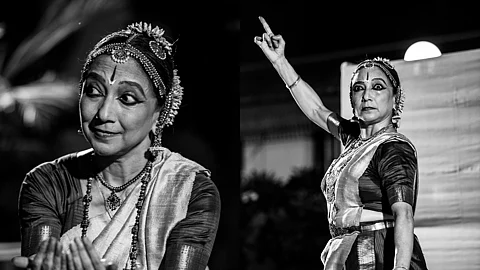
- HOMEGROWN WORLD
- #HGCREATORS
- #HGEXPLORE
- #HGVOICES
- #HGSHOP
- CAREERS
- ABOUT US
- CONTACT US

The Javali is a genre of semi-classical music and dance in South India, particularly associated with traditional Carnatic music and the classical dance traditions of Bharatanatyam and Kuchipudi. While its roots span the broader South Indian cultural sphere, Karnataka holds a special place in the evolution and preservation of the Javali form, primarily through composers from Mysore and other cultural centers in the region.
In both Bharatanatyam and Kuchipudi, javalis are used to highlight abhinaya, or expressive, emotive storytelling through exaggerated facial expressions and hand gestures. Unlike padams, which are slow and introspective, javalis are brisker, flirtier, and more dynamic, often brimming with shṛiṅgāra rāsā or the erotic mood of yearning and the pursuit of carnal desire involving playful or frustrated lovers.
What Is A Javali? A Short Guide To Its Form & Style
Although the origin of javalis is contested among scholars, the genre likely originated in the Kingdom of Travancore during the reign of Sri Swathi Thirunal Rama Varma III in the 19th century. From there, it spread across the Deccan through travelling minstrels and troubadours and found fertile ground in the royal court of Mysore. King Krishnaraja Wodeyar III (reign 1799–1868), himself a trained musician and poet, composed secular javali verses in Kannada, which were collected in the Anubhava Pancharatna. His court nurtured the genre through composers like Chinniah of the famed Tanjore Quartet, who wrote several javalis while in Mysore. This royal patronage gave javalis a distinctly regional flair, with lyrics in Kannada and Telugu tailored for local dance traditions.
Javali lyrics often channel the inner voice of a heroine, the nāyikā, who pines, teases, or confronts her elusive lover, the nāyaka, or hero. These songs brim with passion, flirtation, vulnerability, and dramatic tension. The nāyikā is often portrayed as long-suffering, and the nāyaka is usually unaware or unmoved. This contrast fuels the emotional charge of these songs. Musically, javalis are set in lighter ragas and talas, often omitting the expansive development of a kriti. Instead, they rely on catchy refrains and melodic immediacy. Compared to the devotional gravitas of padams, javalis emphasize a fast-paced tempo and tonal playfulness.
The Rise, Decline, And Revival Of Javalis
In the 19th and 20th centuries, javalis became an integral part of Bharatanatyam and Kuchipudi repertoires, typically performed by court dancers and devadasis just before the final thillana, a highly rhythmic piece in traditional Carnatic music that is generally performed at the end of a concert and widely used in classical Indian dance performances. Their lively tone and compact form allow dancers to explore abhinaya (expressive storytelling) while offering a brief respite before the climactic finale.
As Malini Nair writes in her recent article in Scroll: "It was in the salons of the sought-after courtesans of Madras Presidency patronised by elite men that the javali peaked as a creative form in the early 20th century." Over the 20th century, however, javalis faded from public performance. With the decline of the exploitative devadasi tradition and the rise of conservative cultural values, these sensuous songs were deemed too unsavoury for gentrified society.
In recent years, however, this once-outcast musical tradition is undergoing a revival. In 2025, dancer Leela Samson and vocalist Savita Narasimhan staged a concert in Bengaluru that brought rarely performed javalis back into the spotlight. Unlike the athleticism of modern dance pieces, javalis require being in step with inner stillness. These seemingly simple, sexually-charged songs contain hidden, introspective, gestural depth. They demand incredible breath control, emotional attunement, and an intuitive feel for nuanced phrasing, often unanchored by the limitations of a strict meter.
The Present And Future Of Javalis
Today, javalis exist at the uneasy intersection of sensual self-expression and sexual exploitation. While some read its sensual imagery as metaphor for divine yearning, others reject this spiritual framing as a sanitising move. Despite the controversy surrounding their erotic nature, however, javalis remain luminous artefacts of South India's rich cultural imagination because of their lyrical beauty and melodic charm. Even as they challenge performers to confront questions of sensuality, spiritual desire, and sexual autonomy, their stories of longing and playful erotic desire remain universally resonant.
If you enjoyed reading this, here's more from Homegrown:
Books Of Desire: A Brief History Of South Asia’s Trysts With Erotic Literature
Watch A Groundbreaking Theatrical Exploration Of Greed, Morality, & Desire
